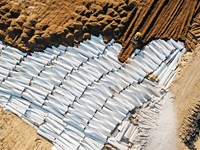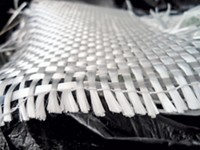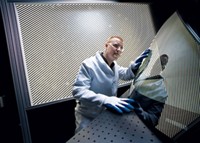Advertisement
Grab your lab coat. Let's get started
Welcome!
Welcome!
Create an account below to get 6 C&EN articles per month, receive newsletters and more - all free.
It seems this is your first time logging in online. Please enter the following information to continue.
As an ACS member you automatically get access to this site. All we need is few more details to create your reading experience.
Not you? Sign in with a different account.
Not you? Sign in with a different account.
ERROR 1
ERROR 1
ERROR 2
ERROR 2
ERROR 2
ERROR 2
ERROR 2
Password and Confirm password must match.
If you have an ACS member number, please enter it here so we can link this account to your membership. (optional)
ERROR 2
ACS values your privacy. By submitting your information, you are gaining access to C&EN and subscribing to our weekly newsletter. We use the information you provide to make your reading experience better, and we will never sell your data to third party members.
Inorganic Chemistry
Automotive glass presents unique challenges for manufacturing and recycling
Glass recyclers are finding ways to reuse this high-tech material that is designed for passenger safety, optical clarity, driving comfort, and energy efficiency
by Mitch Jacoby
April 24, 2022
| A version of this story appeared in
Volume 100, Issue 14

Credit: Mitch Jacoby/C&EN | Designed for safety during powerful collisions, tempered window glass breaks apart into tiny, rounded pieces, while laminated windshield glass cracks but remains in the frame.
In brief
Automotive glass is designed to withstand the wind forces of high-speed driving, resist impacts from kicked-up road debris, and support the cabin structure during collisions. If the glass breaks, it is engineered to not break into dangerous, sharp shards. By tuning the composition and structure of automobile glass, manufacturers produce a rugged safety material that provides drivers and passengers with a clear view of their surroundings while controlling the cabin temperature and acoustics as well as the vehicle’s weight and energy efficiency. But this complex engineering makes the material challenging to recycle compared with other types of glass. Companies are finding ways to overcome these challenges and reduce the environmental impact of this multibillion-dollar industry.
Earlier this year, Riley Leon made headlines when he survived a tornado that flung his pickup truck across a highway. His story highlights the safety engineering that goes into automotive glass.
On March 21, Leon was driving along US Route 290 in Elgin, Texas, when tornado winds topping 210 km/h knocked over his pickup truck, spun it round and round, and eventually uprighted it. Despite the violent thrashing that heavily damaged the truck and blew out some windows, Leon received little more than minor scratches. That was in part because the windshield and rear window remained intact, preventing him from being ejected from the vehicle or injured by a collapsing cabin frame. Those protective features are engineered into the truck’s safety glass.
Safety is one of several design needs of glass for automobiles. The glass has to be optically clear to provide drivers and passengers with an undistorted view of their surroundings, but it also needs to selectively transmit light to help drivers see clearly without squinting and to keep the interior cool on hot, sunny days. It needs to be strong to resist high-speed winds and impacts from small stones during highway driving. Windshields and sunroofs, in particular, must be structurally rugged to support the cabin frame and prevent the roof from buckling and harming passengers during rollovers. And if the glass does break, the pieces should remain in the window frame or break into small, rounded chunks, not large, jagged shards that can cut, maim, or kill the occupants. The glass also must be as light as possible to maximize fuel efficiency, must control the acoustics for cabin comfort, and should provide various tints and colors for aesthetics and privacy.

Tailoring glass to affordably provide all these functionalities requires striking the right balance among glass properties, says Thibaut Heitz, director of R&D at Paris-based Saint-Gobain Sekurit, a multinational glass company. To achieve this custom combination of properties, glass scientists and engineers fine-tune the material’s composition and further tailor its properties through tempering, chemical strengthening, laminating, coating, and other procedures.
As a result, automotive glass manufacturing is complicated. It’s also growing. Worldwide, manufacturers produced an average of roughly 90 million passenger cars and commercial vehicles per year in the past 10 years, according to the International Organization of Motor Vehicle Manufacturers. Industry watchers predict that number will grow steadily in the next decade. As it does, the global automotive glass market will also grow, almost doubling from approximately $15.5 billion in 2021 to $31.1 billion in 2028, according to Fortune Business Insights, a market analysis firm. The size of the market is driving recyclers to create innovative ways to reclaim waste auto glass and turn it into valuable products, thereby reducing this industry’s environmental footprint. The various manufacturing steps that tailor automotive glass and provide it with a unique combination of properties present special recycling challenges, but ones that the industry is working to overcome.
Glass composition
Like glass used for making bottles, jars, and ordinary building windows, the glass found in cars, trucks, and buses is known as soda-lime glass. It’s the most common type and accounts for roughly 90% of all manufactured glass. The material’s main ingredients include sand as an abundant source of silica, sodium carbonate (soda ash), and calcium carbonate (limestone). To form glass, manufacturers blend the raw ingredients and feed them to a furnace that heats the mixture above 1,500 °C, forming a molten material that is shaped into bottles or other products as it cools.
Not all soda-lime glass looks alike. Glassmakers generally customize the formulation to control the color, which varies by application. Beer, for example, often comes in brown bottles to prevent unwanted photooxidation. For some homes and art displays, designers may choose brilliant colorless glass made from highly purified starting materials.
For automotive applications, the soda-lime glass ingredients may also include iron oxide, a tinting agent that imparts a greenish color to the glass. The tint reduces light transmission into the cabin, Heitz explains. This reduction makes it easier for the driver to see the road clearly in strong sunlight. The tint also helps keep the interior cool by blocking infrared (IR) wavelengths, he says. A cooler cabin leads to less demand for air conditioning, which reduces fuel consumption and lowers emissions of carbon dioxide in gas- and diesel-powered cars and extends driving range in electric vehicles.
Other inorganic compounds play a similar role in controlling light transmission, but they impart other tint colors. Cobalt, for example, provides a neutral blue-gray tint. And glassmakers often use a combination of compounds containing iron, manganese, and selenium to produce what the industry calls privacy glass. In addition to cutting light and heat penetration and looking elegant, this dark glass, which is commonly found in rear windows of sport utility vehicles (SUVs) and many luxury cars, offers back-seat occupants some privacy and deters theft by keeping the car’s contents out of sight.
Coating windshields and sunroofs with metal films is a highly effective but more complex way to control light and heat in the cabin, says Eric Rogers of AGC (formerly Asahi Glass), a technical expert on the company’s intellectual property. In this procedure, glassmakers often sputter deposit one or more nanometer-thin layers of silver separated by layers of metal oxides such as tin oxide or titanium dioxide. The thinness of the stacks allows this optically engineered structure to strongly reflect IR wavelengths, thereby minimizing cabin heating without coloring the glass silver, which would sacrifice visibility, Rogers says.
Tempered glass for safety
Broken glass can be fatal, especially during high-speed collisions, when the glass can fly into the cabin or people can be thrown against a broken window. For that reason, carmakers build automobiles with two types of safety glass. Side and rear windows are generally made from specially heat-treated, or tempered, glass. Windshields are universally made from laminated glass, which has a glass-polymer sandwich structure.
Manufacturers prepare tempered glass, which has been widely used in automobiles since the 1950s, by heating the glass to more than 600 °C, then quenching it quickly by blasting it for just a few seconds with high-pressure cold air, says Michael Richardson, a technical specialist in automotive glass at General Motors. The treatment makes the glass about four times as strong as ordinary annealed (slow-cooled) window glass. If it does break, tempering leaves the glass prone to shattering into many small, rounded pieces with relatively few sharp edges. These fragments are less likely to cut occupants than the large, jagged shards that typically form when common window glass breaks.
The cold air rapidly cools molecules at the surface, locking them in place in a state of high compression, which strengthens the surface, says Thomas Cleary, an automobile glass expert at Corning. At the same time, the molecules in the hot core are slower to cool and continue to vibrate freely until they do. “That leads to a density difference that sets up a tug-of-war between molecules in the core and at the surface,” Cleary says. As a result of that internal tension, when tempered glass breaks, it rapidly explodes into tiny pieces, releasing that pent-up energy.
Laminated windshields

Car safety has evolved a lot over the years. The earliest cars didn’t have windshields. Those began appearing around 1904, but they didn’t become standard equipment until more than a decade later.
The story of laminated glass for windshields dates back to 1903, when Edouard Benedictus, a French artist and chemist, made an unexpected observation while working in his lab. When Benedictus accidentally knocked a glass beaker to the floor, he was surprised to see that the beaker broke but the pieces of glass remained together, retaining the shape of the glassware. Benedictus had been working with a solution of nitrocellulose and the solution evaporated, coating the glassware with a tough film that held the glass fragments in place.
At that time, automobiles were growing in popularity, and injuries caused by broken glass during car collisions were on the rise. Benedictus saw a way to protect motorists by making windshields from toughened, polymer-coated glass that resisted shattering and stayed in the windshield frame if it did break. After a few years of development, he patented a safety-glass laminate composed of two layers of plate glass that sandwiched a film of cellulose.
By 1920, a number of companies made laminated glass for windshields and other applications, but early versions of this safety glass often discolored as the plastic interlayer film aged. Glass companies and carmakers found that polyvinyl butyral (PVB) resisted discoloring, and within a decade, several companies began using this material to laminate windshields. As a result of worldwide safety regulations implemented since the 1960s, laminated windshields are now standard everywhere, and although various materials have been used as interlayers, PVB remains the most common one.
The basics of PVB chemistry were identified 100 years ago, according to Travis Smith, president of Eastman Chemical’s films division, a major supplier of PVB for laminated glass. PVB remains the top choice for windshield interlayers because of its safety characteristics and optical clarity, Smith says. In addition, PVB can be tailored to control acoustics, block solar heating, and integrate displays and other electronic devices. And importantly, it can be produced economically at an industrial scale, he says.
To make laminated windshields, manufacturers cut sheets of soda-lime glass, roughly 2.5 mm thick, and shape them in a furnace to fit a car’s curved windshield frame. Then they bond the glass and PVB film in a hot, pressurized vessel known as an autoclave. The procedure causes the PVB to thoroughly wet the glass surface, which leads to intimate mechanical contact between the layers, says Alan K. Phillips, Eastman’s R&D director for films. It also drives hydrogen bonding between the layers, further strengthening the laminate, he says. The result is a tightly bonded, tough, transparent material that resists shattering by flexing on impact.
Chemical strengthening also plays a role in making windshields tough. In 2017, Ford debuted a windshield made from a laminated hybrid of ordinary soda-lime glass on the car’s exterior and a thin piece of Corning’s Gorilla Glass, a chemically strengthened aluminosilicate material, on the interior. Corning’s Cleary explains that the strengthening in Gorilla Glass comes from ion-exchange chemistry that causes potassium ions to replace some of the sodium ions in a thin surface layer. Potassium’s large size relative to sodium leads to compressive forces that toughen the glass surface by raising roadblocks that prevent cracks from propagating.

Before introducing the hybrid windshields, Ford and Corning ran various tests simulating impact with blunt and sharp stones on the glass. It took more than twice as much impact energy to form star cracks in the hybrids as it did in conventional windshields. And because the Gorilla Glass ply in 2017 was much thinner and lighter than other types of glass, the windshield’s weight was cut by about 30%, nearly 7 kg for some SUVs, Cleary says. Since then, the glass has become even thinner and lighter, which reduces fuel consumption and emissions of greenhouse gases, and extends driving range in electric vehicles.
Recycling challenges

Glass can be recycled repeatedly with no loss in the quality of containers, windows, and other products made from it. Most glass is recycled by crushing it to form cullet, removing impurities and sorting by color, and then blending the cullet with sand and other raw ingredients, which are melted in the furnace to make new glass. Using cullet in this way reduces glass manufacturers’ need for raw materials. It also reduces the energy required to keep the furnace at temperatures high enough to generate molten glass, which lowers greenhouse gas emissions and operating costs and keeps glass prices in check. Glass recyclers process tempered window glass in much the same way as container glass—crush, clean, sort, and ship the furnace-ready cullet to manufacturers, says Mark Nelson, a vice president at Strategic Materials, the largest cullet supplier in the US.
But the same features that make windshields tough and safe also make them difficult to recycle. By design, the glass is tightly bonded to the rubbery sheet of PVB and adheres strongly even after the glass breaks, Nelson says. So even though glass recyclers process many millions of metric tons of container glass annually, they have traditionally recycled very few windshields. This is especially true in the US, which lags far behind many countries when it comes to recycling container glass. Broken windshields often ended up in landfills.

Andela Products is a company that has developed one way to pry the materials apart. Cynthia Andela, president and CEO of the company, describes the method as based on a hammer-and-chisel-like approach. Equipment beats the windshield from both sides simultaneously—repeatedly and at high speed, fracturing the glass and mechanically peeling it from the PVB. The stripping process yields millimeter-sized cullet and larger pieces of PVB.
Nearly all glassmakers use cullet to manufacture new products, so the reclaimed windshield glass is readily recycled. What about the PVB? Shark Solutions, based in Denmark, is one of a handful of companies that processes broken windshields and recycles the film. The company, which also operates in the US and Belgium, purifies the PVB and converts it to pellets and water-based dispersions. Manufacturers use those materials to make carpet backing, binders for paints, adhesives, fabric coatings, and other industrial products.
Advertisement
“Interest in recycling windshields has really grown in the past few years,” Andela says. People are focused on sustainability and reducing the volume of material sent to landfills. They see opportunities to recycle windshields into useful materials, she says.
Worldwide, some 75 million broken windshields are replaced annually, according to industry estimates. Recycling the PVB reduces the number that goes to landfills and lowers carbon emissions by sidestepping the need to make new polymer, says Shark Solutions vice president Rob Crivello. “It gives us a measure of fulfillment to know that this waste is no longer considered waste. It’s recycled because it’s valuable.”





Join the conversation
Contact the reporter
Submit a Letter to the Editor for publication
Engage with us on Twitter